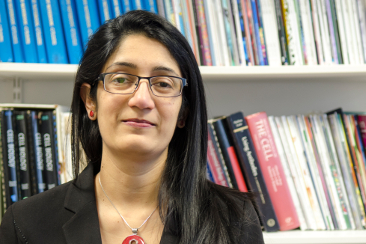
Dr Navita Somaiah is a Clinician Scientist Fellow at the ICR
Last year, the ICR awarded funding to a large multidisciplinary research project headed by Head of Data Science Dr Bissan Al-Lazikani and Clinician Scientist Dr Navita Somaiah. They brought together a collaborative team to study risk factors for radiotherapy toxicity in prostate cancer patients using Big Data analysis.
At a recent ICR Future Leaders event, Dr Somaiah spoke about her experiences of leading the project. She shared some practical tips about successfully working on team science projects.
Q: What is the team working on?
NS: Two-thirds of cancer patients are treated with radiotherapy at some point during their treatment, but up to 20% of them can experience side-effects from this treatment, often irreversible and affecting their quality of life. Our project team came together to find a way to predict the patients most likely to experience treatment toxicity so we can adapt treatment for different groups accordingly.
Most studies looking at the causes of toxicity after radiotherapy only look at one type of data at a time, as it’s complicated to combine different data in an analysis. In this project we’re combining the full spectrum of different types of data – including genetic information and radiotherapy dose, as well as information like patient-reported outcomes and notes from clinicians.
Q: What’s your role in the team?
NS: I co-lead the project team with Dr Bissan Al-Lazikani. It’s a large team made up of 16 people including computational biologists, clinicians, statisticians, and physicists. Bissan and I manage the team, set the priorities and timelines, and keep everything on track. But the work is very much a team effort.
Q: What advice would you give others thinking of setting up a multidisciplinary project?
NS: Working as part of a large and diverse team has its challenges but is a hugely rewarding experience. Keep talking to each other openly and freely, and deal with problems as they arise.
Be sure from the start to have a set of ground rules. At our kick-off meeting we agreed that intellectual property rests with the team and major decisions couldn’t be made outside of team meetings. We also set up a mailing list for the group so that nobody misses out on key information.
Work hard to find a common language so that everyone understands what is being discussed. Sometimes one of us might slip into talking in fantastically geeky equations for example, but if anyone gets too technical we just stop them and ask them to explain. We are constantly learning from each other and this is a very rewarding aspect of team science.
Q: And how are you ensuring that each member of the team is recognised for their contribution?
NS: One of the major challenges for collaborative working is that career progression for researchers is often driven by their track record of publications and their position in the author list. We expect to have multiple publications from the work that we’ve been doing – some more technical and some more clinical – and we agreed right at the outset that all members of the team will be on all the publications arising from this work. There is also scope to have multiple first and senior authors, to reflect our true team science approach.
Q: What’s next for the team?
NS: We’ll be presenting our initial data at the ICR conference later this year. The prize money from the Team Science Competition has acted as a pump-prime allowing us to generate important preliminary data. We’ll now apply for grants to fully fund this project and apply this approach to other radiotherapy data sets for breast and prostate cancer patients. Our focus will remain on predicting side-effects but we will also expand this to look at treatment response and tumour control.
We’re starting to see real advances through applying Big Data analysis to the discovery of drug targets and treatments – I’m excited to see how much we can achieve by applying a Big Data approach to radiotherapy research, allowing us to intelligently tailor treatment to individual patients. If we’re successful, these approaches can be used across other tumour types where radiotherapy forms part of the treatment.